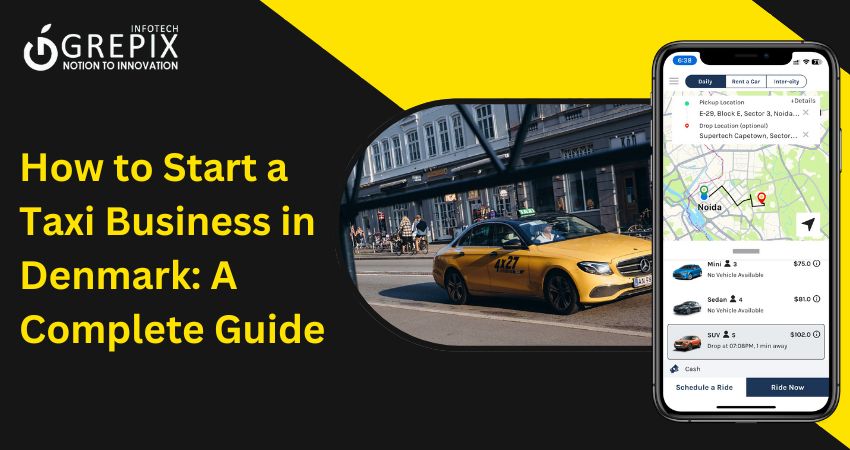How to Start a Taxi Business in Denmark: A Complete Guide
Starting a taxi business in Denmark presents an exciting opportunity to tap into a well-regulated and technologically advanced market. With an emphasis on quality, safety, and sustainability, Denmark’s taxi industry is evolving rapidly, making it the perfect time to enter this lucrative sector.
Launching a taxi business in Denmark is a promising venture with ample growth opportunities. By ensuring compliance with regulations, integrating modern technology, and focusing on customer satisfaction, your business can thrive in Denmark’s competitive transportation market. This comprehensive guide will walk you through all the essential steps, from understanding regulations to integrating advanced technology, ensuring your taxi business is competitive and successful.
Starting a taxi business in Denmark presents a lucrative opportunity in a well-regulated and tech-driven market. With a focus on quality, safety, and sustainability, the industry is evolving rapidly. Entrepreneurs must comply with licensing requirements, adopt modern technology, and provide exceptional customer service to succeed. Key considerations include fleet selection, technology integration, pricing strategies, and driver recruitment. A strong business plan and marketing strategy will enhance visibility and growth. With Denmark’s increasing demand for eco-friendly and premium transport options, now is the ideal time to enter the market. Partnering with Grepix Infotech ensures a seamless, tech-powered taxi service.
1 Understanding the Denmark Taxi Industry
Denmark’s taxi industry blends tradition with modern innovation, emphasizing quality, safety, and sustainability. The rise of ride-hailing apps has fueled significant growth, while strict licensing regulations maintain high service standards. Eco-conscious customers increasingly seek greener transport options, creating opportunities in niche markets such as luxury rides and wheelchair-accessible services. Aligning your business with these trends will help it stand out and thrive in this competitive landscape.
2 Legal Requirements and Permits
Starting a taxi business in Denmark requires navigating multiple legal processes. Obtaining a taxi license through local municipalities is crucial, with requirements including financial stability and relevant experience. Regional regulations, such as taxi number restrictions, help prevent oversaturation. Additionally, cities may have unique operational guidelines, including route limitations and fare structures. Consulting legal experts can simplify compliance, saving both time and effort.
3 Business Planning Essentials
A well-structured business plan is key to success. Conduct market research to analyze competitors and target customers. Plan finances carefully, covering vehicle acquisition, licensing, insurance, and operational costs. Define a unique selling proposition (USP), such as eco-friendly taxis, luxury services, or competitive pricing, to differentiate your business. A solid plan acts as both a strategic roadmap and a tool for attracting investors, ensuring your business is well-prepared for future challenges.
4 Registering Your Taxi Business in Denmark
To operate legally, you must register your business with the Danish Business Authority (Erhvervsstyrelsen). Choose an appropriate business structure, such as a sole proprietorship, partnership, or private limited company. If your annual revenue exceeds DKK 50,000, VAT registration is required for tax compliance. Additionally, setting up a NemID (Denmark’s digital ID) is essential for interacting with government agencies and managing finances. Proper registration ensures smooth operations and prevents legal issues.
5 Acquiring the Necessary Fleet
Your taxi fleet is the foundation of your business, making vehicle selection a critical decision. Danish customers prioritize sustainability, comfort, and efficiency. Consider the following vehicle types:
- Standard Sedans: Ideal for everyday commuters seeking affordable rides.
- Luxury Cars: Cater to premium customers and business travelers.
- Eco-Friendly Vehicles: Hybrid and electric cars align with Denmark’s sustainability goals.
- Accessible Vehicles: Wheelchair-friendly taxis can expand your customer base and meet social needs.
6 Technology Integration
Booking and Dispatch Systems
Implement cloud-based systems to manage ride bookings and driver assignments efficiently. GPS integration enables real-time tracking and optimized route planning.
Mobile Applications
Develop a user-friendly app with features like fare estimation, ride tracking, and multiple payment options. Offering support in Danish and English can enhance accessibility for locals and tourists.
Fleet Management Tools
Invest in software to monitor vehicle health, fuel consumption, and driver performance. Predictive analytics can optimize routes, reduce costs, and improve efficiency.
Leveraging technology ensures a seamless and competitive taxi service in Denmark’s evolving market.
7 Marketing Your Taxi Business
A well-planned marketing strategy is crucial for brand recognition and customer acquisition. A mix of digital and local approaches can drive steady growth.
Online Presence
Build a professional website showcasing your services, pricing, and contact details. Optimize it for search engines with relevant keywords like “taxi services in Denmark.” Enhance local visibility with Google My Business to attract nearby customers.
Social Media Marketing
Utilize platforms like Facebook and Instagram for targeted advertising. Share engaging content, such as customer testimonials and eco-friendly initiatives, to build trust and loyalty. Engage with your audience to foster stronger connections.
Local Partnerships
Collaborate with hotels, airports, and event organizers to secure consistent bookings. Offering referral incentives to partners can strengthen relationships and encourage long-term collaborations. A strategic mix of online marketing, social engagement, and local partnerships ensures a steady customer flow and long-term growth.
8 Setting Your Pricing Strategy
Balancing competitive and fair taxi fares ensures profitability while keeping customers satisfied. A well-structured pricing model attracts riders and sustains business growth.
Understanding Pricing Regulations
Local municipalities regulate Danish taxi fares, typically setting maximum limits. Fares usually consist of a base charge, distance-based rates, and time-based fees. Staying updated on these regulations ensures compliance and avoids penalties.
Competitive Pricing
Research competitors to understand market rates. Position your service as budget-friendly or premium, depending on your target audience. Small pricing adjustments can help differentiate your brand.
Promotions and Loyalty Programs
Attract new customers with introductory discounts and build loyalty through rewards programs, such as free rides after a certain number of trips. Transparent pricing fosters customer trust and enhances competitiveness.
Also Read: "Best Ride-Hailing And Taxi Apps In Denmark"
9 Recruiting and Training Drivers
Your drivers are the face of your brand, ensuring a lasting impression. Careful hiring and training shape a reliable, professional service.
Hiring Process
Prioritize candidates with a valid Danish driver’s license and a clean driving record. Conduct background checks to ensure safety. Hiring bilingual drivers (Danish and English) improves communication and customer service.
Training Programs
Offer training on customer service, booking systems, fleet management tools, and Danish road safety laws. Well-trained drivers enhance service quality and compliance.
10 Financial Management and Growth
Strong financial management is essential for long-term sustainability and business growth. It ensures efficient resource allocation, risk mitigation, and profitability, enabling expansion and stability in a competitive market.
Managing Operational Costs
Monitor fuel, maintenance, and insurance expenses. Fleet management tools can optimize routes and reduce costs. Regular expense tracking helps identify cost-saving opportunities.
Monitoring Cash Flow
Maintain detailed records of earnings and expenses. Use accounting software to streamline bookkeeping and improve financial decision-making.
Scaling Your Business
Once stable, expand by adding more vehicles or offering premium services. Exploring new cities or underserved areas can help grow your customer base. Gradual scaling ensures sustainable growth while minimizing financial risk.
By implementing sound financial strategies, your taxi business can achieve long-term success in Denmark’s competitive market.
Conclusion
Starting a taxi business in Denmark offers immense potential for success in a well-regulated, technology-driven market. By adhering to legal requirements, leveraging innovative solutions, and prioritizing customer satisfaction, you can build a competitive and sustainable business. The demand for eco-friendly and premium transportation services continues to grow, making now the perfect time to enter the industry.
At Grepix Infotech, we specialize in developing cutting-edge taxi app development solutions tailored to the evolving transportation landscape. Our expertise in ride-hailing technology, seamless payment integration, and fleet management ensures your taxi business stays ahead of the competition. Whether launching a new venture or scaling an existing service, Grepix is your trusted partner in building a future-ready, customer-centric taxi business in Denmark.
FAQs
1. What legal requirements must be met to start a taxi business in Denmark?
You need a valid taxi operating license, vehicle permits, and compliance with local municipality regulations.
2. How much investment is required to start a taxi business?
A small-scale taxi business may require DKK 200,000–500,000, depending on fleet size and technology integration.
3. Can I start a taxi business without owning a vehicle?
Yes, you can partner with independent drivers or lease vehicles to reduce upfront costs.
4. Does Denmark offer grants for taxi startups?
Yes, government programs are supporting sustainable transportation businesses.
5. How can I make my taxi business eco-friendly?
Use electric vehicles, optimize routes with GPS, and comply with Danish emission standards.
Looking out to start your own venture like inDrive? Try out our HireMe Taxi inDriver Clone, the easiest way to kick-start your taxi business.








